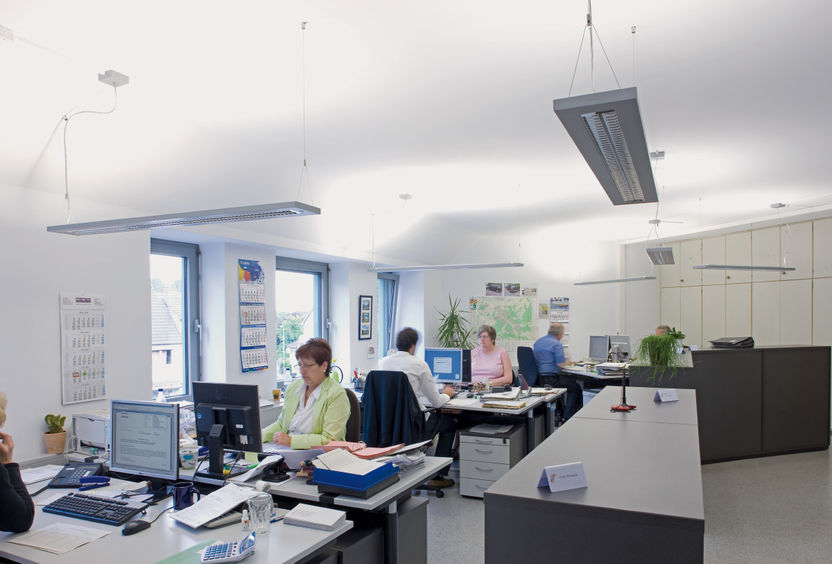
Example for the dertermination of the maintenance factor due to reference values of fluorescent lamps, luminaires and the room

To determine the maintenance factor MF and initial illuminance Ēi (index "i" for "initial"), the intended use of the room as well as further basic parameters to be defined are:
Room: |
Very clean non-smoking office |
Size: |
Medium-sized |
Type of light source: |
Tri-phosphor fluorescent lamps T8 |
Control gear: |
ECG |
Type of luminaire: |
Predominantly direct-distribution specular louvre luminaires with top cover |
Maintained illuminance Ēm in the visual task area: |
500 lx |
Period of operation: |
2,000 h/a |
Maintenance interval: |
3 years |
The partial maintenance factors add up to:
Lamp maintenance factor LaMF = 0,93

Reasons: For tubular tri-phosphor fluorescent lamps with improved luminous flux behaviour in combination with electronic control gear, 6,000 hrs of operation within three years (maintenance interval), immediate replacement of failed lamps, which means only the decrease in luminous flux for the lamps (fig., middle curve) must be estimated.
Luminaire maintenance factor LMF = 0,89

Reasons: See table (luminaire group 3) for a very clean non-smoking office, predominantly direct-distribution specular louvre luminaires with top cover and smooth, non-porous high-purity aluminium surface.
Room maintenance factor RMF = 0,97

Reasons: See table (d) for the medium-sized, very clean non-smoking office with frequent, intensive cleaning of the room, for direct-distribution luminaires.
Maintenance factor
MF = LaMF · LMF · RMF
MF = 0,93 · 0,89 · 0,97 = 0,80
with the partial efficiency factors at the end of the period of use (ηLa,eol, LOReol, Ueol) against their initial values (ηLa,i, LORi, Ui). With three-year installation maintenance, the planning can be based on a maintenance factor of 0,8.
This results in the following initial illuminance to be installed:
Ei = 500 lx/0,8 = 625 lx (it. 1 in fig.).
The result is the following temporal progression of illuminance:
After 3 years, the time m1 of the first maintenance procedure, the illuminance has decreased to a value of 500 lx (it. 2 in fig.). The luminaires are cleaned, luminaire efficiency rises back to the initial value, utilance remains unchanged.
Illuminance after cleaning the luminaires is

and increases to the value

(it. 3 in fig.)
After 3 more years (after a total of 6 years, m2), illuminance changes as follows: Since the lamps were not replaced after 3 years (with 6,000 hrs of operation each), their relative efficiency, based on 12,000 hrs of operation, changes from 0,93 to 0,91 (a safe value, since the 5% of lamps which failed in the meantime were replaced immediately and thus had an operating period of significantly less than 12,000 hrs). Before cleaning, the luminaires have an efficiency reduced by the factor 0,89 due to 3 years of soiling (see table). Relative utilance is nearly constant and decreases from 0,97 to 0,96 (see table).
After 6 years, illuminance is


(it. 4 in fig.)
At the time of planning it is to be assumed that the maintained illuminance will drop slightly below 500 lx after six years of operation. Given that
the initial value of the installation is actually 625 lx
lamps and luminaires are cleaned diligently after 3 years
lamps are replaced immediately upon failure
the room is cleaned frequently and intensively and
the installation is restored to its initial condition after 6 years
the maintenance factor 0,8 can be used in planning.
If these preconditions cannot be ensured or reflectance values of ceiling, walls and floor continue to deteriorate in the 2nd maintenance interval, either the standardised maintenance factor MF = 0,67 or a maintenance factor based on other reference values for lamps, luminaires and room must be determined for planning.